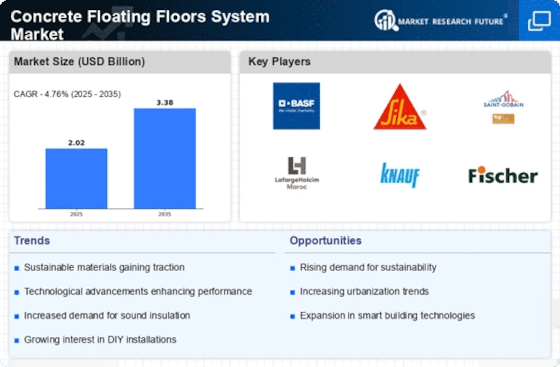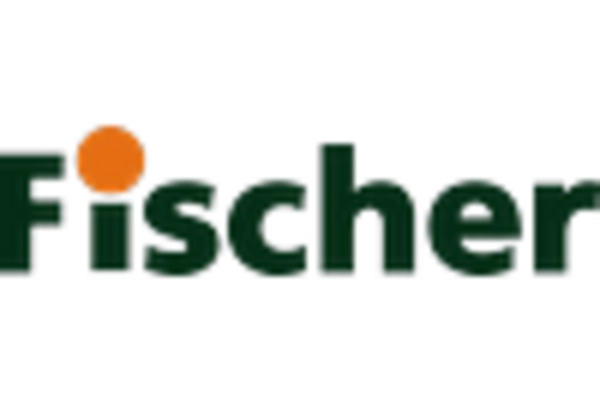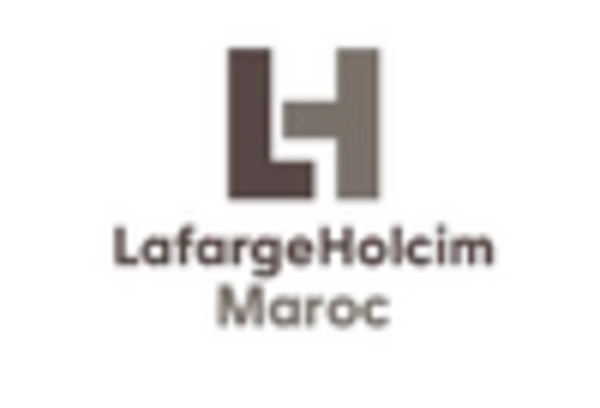Customization Trends
Customization trends are emerging as a significant driver in the Concrete Floating Floors System Market. Consumers are increasingly seeking personalized flooring solutions that cater to their specific aesthetic and functional needs. This demand for customization is prompting manufacturers to offer a variety of finishes, colors, and textures, allowing for greater design flexibility. Market Research Future indicates that approximately 30% of consumers prioritize unique design elements in their flooring choices, highlighting the importance of customization in driving sales. As a result, companies that can provide tailored solutions are likely to capture a larger share of the Concrete Floating Floors System Market. This trend not only enhances customer satisfaction but also fosters brand loyalty, as consumers are more inclined to return to brands that meet their individual preferences.
Regulatory Compliance
Regulatory compliance is becoming increasingly critical in the Concrete Floating Floors System Market. Governments worldwide are implementing stricter building codes and standards aimed at enhancing safety and environmental sustainability. Compliance with these regulations often necessitates the use of high-quality materials and construction practices, which can drive demand for concrete floating floors that meet these criteria. For instance, regulations concerning indoor air quality and emissions are pushing manufacturers to adopt greener practices in their production processes. Data suggests that the market for compliant building materials is expected to grow by 12% in the coming years, indicating a robust opportunity for concrete floating floor systems that adhere to these evolving standards. Companies that prioritize regulatory compliance may not only enhance their market position but also contribute to safer and more sustainable building practices.
Sustainability Initiatives
The Concrete Floating Floors System Market is increasingly influenced by sustainability initiatives. As environmental concerns rise, construction practices are shifting towards eco-friendly solutions. Concrete floating floors, known for their durability and energy efficiency, align with these initiatives. The use of recycled materials in concrete production is gaining traction, potentially reducing the carbon footprint associated with traditional flooring systems. Furthermore, the longevity of concrete floors minimizes the need for frequent replacements, contributing to resource conservation. According to recent data, the demand for sustainable building materials is projected to grow by 10% annually, indicating a robust market for concrete floating floors that meet these criteria. This trend suggests that companies focusing on sustainable practices may gain a competitive edge in the Concrete Floating Floors System Market.
Technological Advancements
Technological advancements play a pivotal role in shaping the Concrete Floating Floors System Market. Innovations in concrete formulation and installation techniques are enhancing the performance and appeal of floating floors. For instance, the introduction of self-leveling concrete has simplified the installation process, reducing labor costs and time. Additionally, advancements in moisture control technologies are addressing common issues associated with concrete floors, such as cracking and warping. Market data indicates that the adoption of advanced technologies in construction is expected to increase by 15% over the next five years, suggesting a growing preference for modern solutions in the Concrete Floating Floors System Market. This trend may lead to improved product offerings and increased market penetration for companies that embrace these technological changes.
Economic Growth and Urbanization
Economic growth and urbanization are significant factors influencing the Concrete Floating Floors System Market. As economies expand, there is a corresponding increase in construction activities, particularly in urban areas. The rising demand for residential and commercial properties is driving the need for efficient flooring solutions, including concrete floating floors. Market data indicates that urbanization rates are projected to increase by 2% annually, leading to heightened construction activities. This trend suggests a growing market for concrete floating floors, as they offer durability and cost-effectiveness, making them an attractive option for builders and developers. Furthermore, as urban populations grow, the demand for sustainable and efficient building materials is likely to rise, further bolstering the Concrete Floating Floors System Market.

















Leave a Comment